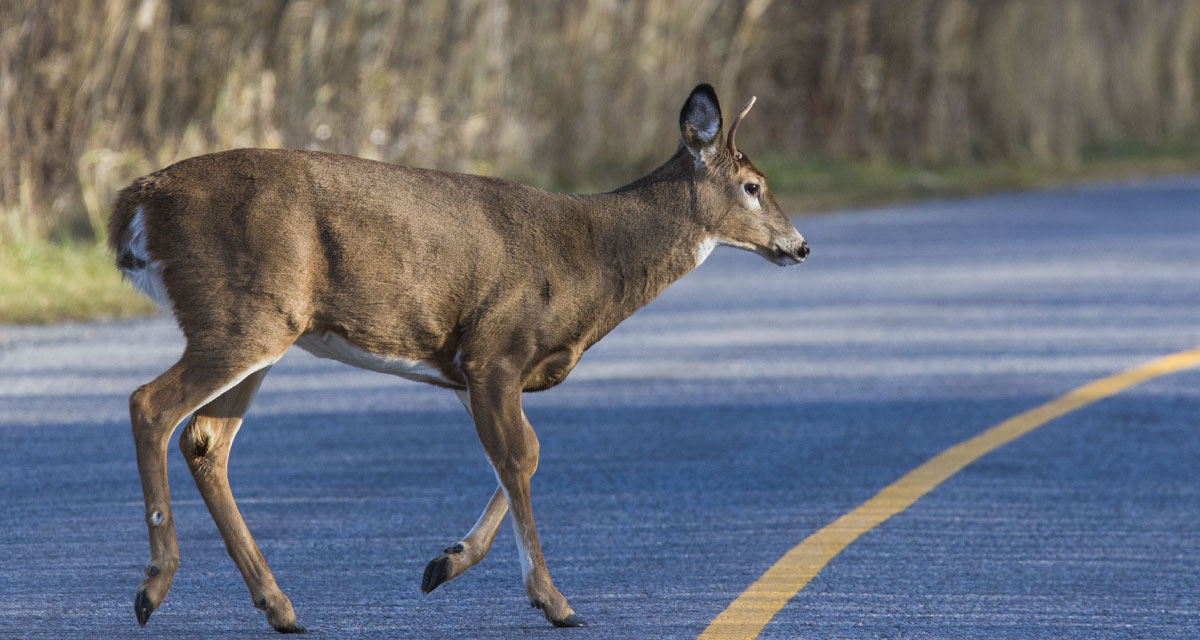Encountering wildlife in nature can be a beautiful spectacle. Vehicles on rural, country roads often witness deer running and jumping or turkey flying or waddling in their natural environment. In seconds, however, an unsuspecting driver, who discovers they are in the path of a creature, may swerve or hit the breaks in panic, leading to a devastating outcome. As drivers, we must be aware that animals are forced from their dwindling woodland homes to meander onto residential streets and highways, placing them in a path of moving vehicles. Fall through winter, drivers need to be vigilant and remember to adhere to the following safety suggestions.
Watch the Signs
In North Carolina, drivers are unlikely to find a “Wildlife Warning Sign” which is bright yellow and diamond-shaped along the roadside; yet, they do exist! Signs indicate the location of high-risk collision areas, however, without the notification, drivers can become aware of other warnings. For instance, if you are between a dense population of trees, such as a back-road or highway, begin by decelerating, turn on high beams if alone and watch for movement. As a result, drivers are more likely to spot wildlife at a distance!
Additional recommendations:
- Rather than keep your eyes straight ahead, scan both sides of the road frequently.
- Look for shining eyes!
- Be aware of reflectors near roadsides that appear and disappear.
- Flashing lights from oncoming motorists, warning of danger ahead.
Studies conclude many wildlife vehicular accidents occur when experiencing ideal conditions such as dry, straight stretches of road on a clear night.
Dusk to Dawn
Nighttime may appear as the ideal time to travel, believing fewer vehicles are on the road thus allowing you to reach a destination quickly. Between October to early January, deer and other animals seeking mates are active and usually travel in large packs between 6-9pm. Drivers susceptible to the effects of white noise and darkness are often unable to react in time to prevent a collision.
The best strategies are:
- Remain on high alert by taking frequent stops, walking and remaining hydrated. Remember, wildlife, especially bears, will travel long distances seeking locations where food is present, therefore, slow down when driving past the highway and rest stop exits.
- Keep a towel and glass cleaner on hand to maintain clean headlights and windshield.
- Determine if your headlights are bright enough; if not, reference your car manual to consider upgrading to a slightly higher wattage. (Check your car manual for information.)
How to Avoid a Collision
Unexpected accidents do happen; yet, the driver’s action may only result in structural damage to a vehicle. Rely on what’s in hands reach, such as hitting the horn in a series of short bursts or consider flashing bright lights, whenever possible, to deter sighted animals from traveling in your pathway. This action also alerts other drivers of the danger.
- Try and remain calm!
- Wear your seatbelt; especially encourage passengers in the second and third row.
- If an impact is coming, it’s best to release your brakes, preventing the hood from lowering and resulting in an animal to lift and hit the windshield.
- Remain in your lane!
- Instruct all passengers to lean away from the vehicle’s center. This one action can keep interior bodies safe should an animal roll over the roof and force its collapse.
- After a collision, never touch an injured animal; instead, pull off to the side immediately and call the police directly. While most drivers neglect to report wildlife accidents, the written report of an officer can help insurance claims and out-of-pocket expenses. Reach out to your agent to learn if your insurance covers wildlife collisions. It may be vital to add comprehensive coverage to your policy.
Goals for NC Wildlife Federation
North Carolina maintains a staggering 80,000 miles of highway. Elk, black bear, white-tailed and other species of deer are not the only creatures wandering through our beautiful state; dogs, squirrels, snakes, turtles, birds and a diverse insect population also become victims on and along the road. The NC Wildlife Federation works tirelessly to advocate for wildlife crossings, which support natural, pollinating-friendly areas to deter animals from roads. Building bridges to restore and enhance habitats are continuing projects throughout urban and residential areas. Start today by having a family discussion about wildlife safety! Young drivers ranging in age between 16 and 24 are most susceptible to vehicle collisions with wildlife. By knowing and sharing the facts and strategies, you are helping to prepare friends and family for the unexpected dangers on the road!























